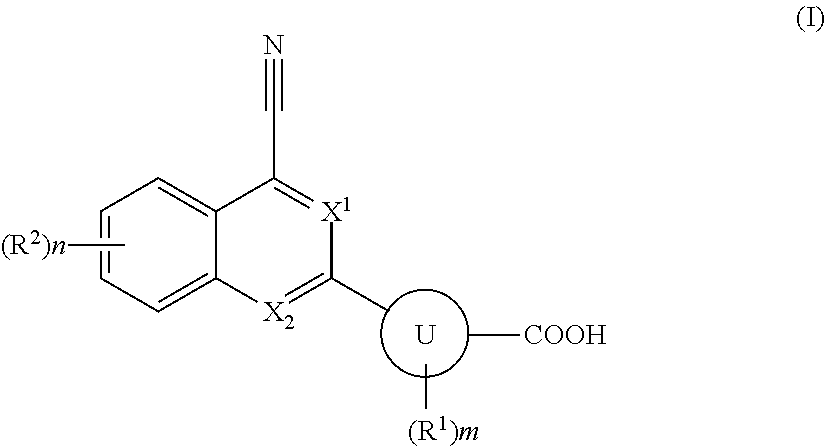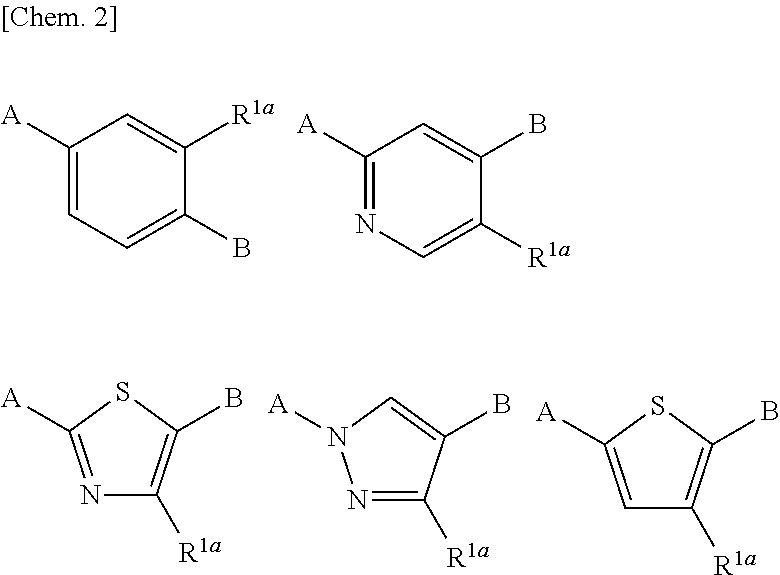Fused-ring derivative and medical application of same
a technology of fused rings and derivatives, applied in the field of fused rings derivatives, can solve the problems of increasing the incidence of liver disorders, increasing the incidence of uricosuric drugs, and reducing the excretion of oxypurinol, and achieves excellent urat1 inhibitory activity, suppressing the production of uric acid, and excellent xanthine oxidase inhibitory activity
- Summary
- Abstract
- Description
- Claims
- Application Information
AI Technical Summary
Benefits of technology
Problems solved by technology
Method used
Image
Examples
reference example 1
3-Bromonaphthalene-1-carbonitrile
[0159]To a solution of 3-bromonaphthalene-1-carboxylic acid (0.30 g) in tetrahydrofuran (3 mL) was added 1,1′-carbonyldiimidazole (0.29 g) under ice-cooling, and the mixture was stirred at room temperature for 2 hours. To this reaction mixture was added ammonia water (1.0 mL, 28% aqueous solution), and the mixture was stirred at room temperature for 4 hours. The reaction mixture was concentrated under reduced pressure. To the residue was added water, and the mixture was stirred at room temperature for 15 minutes. The precipitated solid was collected by filtration. The obtained solid was washed with water and 1 mol / L hydrochloric acid, and dried to give 3-bromonaphthalene-1-carboxylic amide (0.28 g).
[0160]To a solution of the obtained compound (0.27 g) in dichloromethane (5 mL) were added triethylamine (0.44 g) and trifluoroacetic anhydride (0.47 g) under ice-cooling, and the mixture was stirred at room temperature for 6 hours. To the reaction mixture...
reference example 2
4-Cyano-2-naphthaleneboronic acid
[0161]To a solution of 3-bromonaphthalene-1-carbonitrile (0.69 g) and triisopropyl borate (0.89 g) in tetrahydrofuran (10 mL) was added n-butyl lithium (1.6 mL, 2.63 mol / L heptane solution) at −78° C. under an argon atmosphere. After warming to room temperature, the mixture was stirred at room temperature overnight. To the reaction mixture was added a saturated ammonium chloride aqueous solution at room temperature, and the mixture was extracted with ethyl acetate. The organic layer was washed with a saturated ammonium chloride aqueous solution and brine, dried over magnesium sulfate, and concentrated. The residue was suspended in n-hexane, and the solid was collected by filtration. The obtained solid was suspended in water. The suspension was acidified with hydrochloric acid, and the mixture was stirred for 30 minutes. The solid was collected by filtration, washed with water, and dried under reduced pressure to give the title compound (0.49 g).
reference example 3
2-Chloroquinoline-4-carbonitrile
[0162]The title compound was prepared in a similar manner to that described in Reference Example 1 using 2-chloroquinoline-4-carboxylic acid instead of 3-bromonaphthalene-1-carboxylic acid.
PUM
| Property | Measurement | Unit |
|---|---|---|
| temperature | aaaaa | aaaaa |
| temperature | aaaaa | aaaaa |
| temperature | aaaaa | aaaaa |
Abstract
Description
Claims
Application Information
 Login to View More
Login to View More - R&D
- Intellectual Property
- Life Sciences
- Materials
- Tech Scout
- Unparalleled Data Quality
- Higher Quality Content
- 60% Fewer Hallucinations
Browse by: Latest US Patents, China's latest patents, Technical Efficacy Thesaurus, Application Domain, Technology Topic, Popular Technical Reports.
© 2025 PatSnap. All rights reserved.Legal|Privacy policy|Modern Slavery Act Transparency Statement|Sitemap|About US| Contact US: help@patsnap.com



